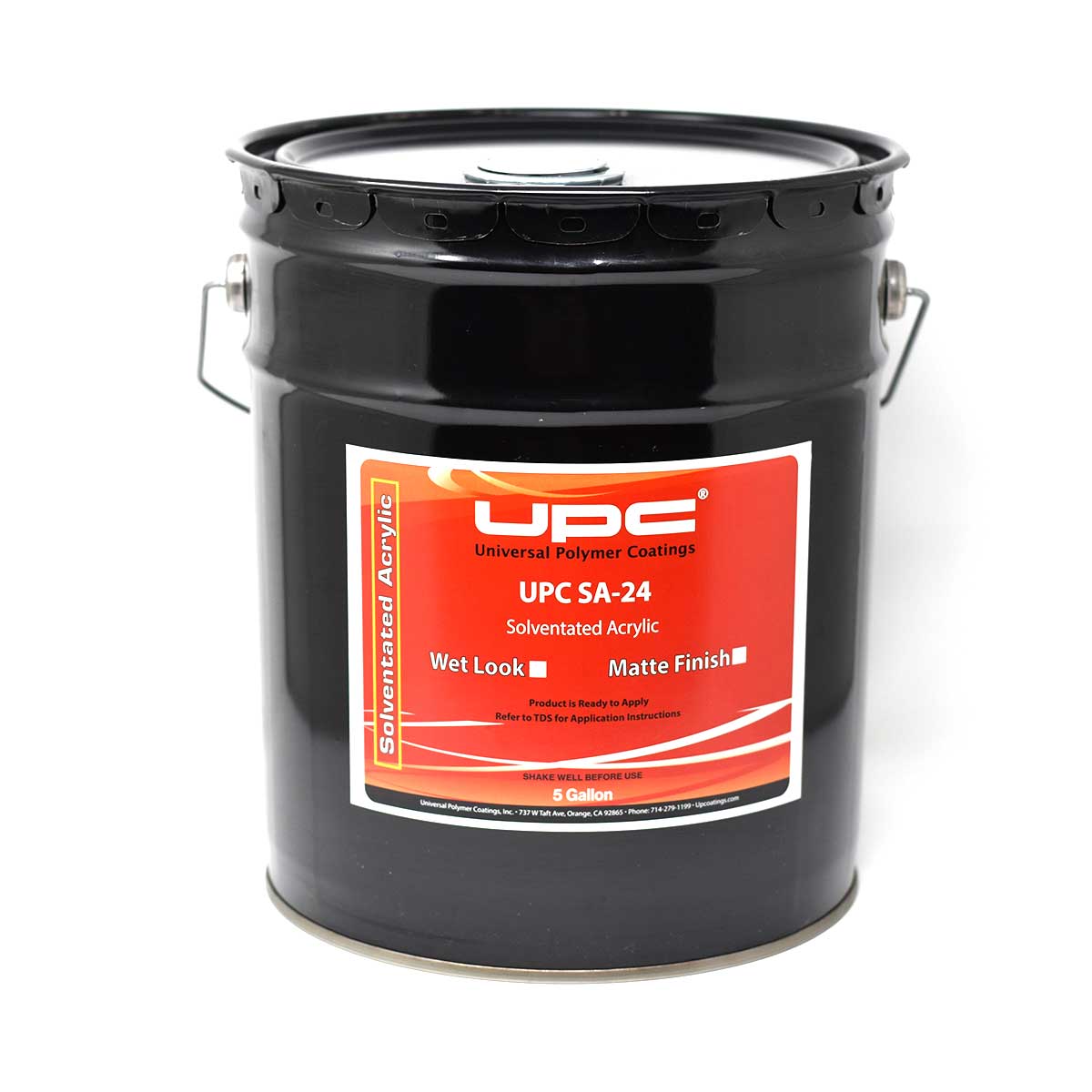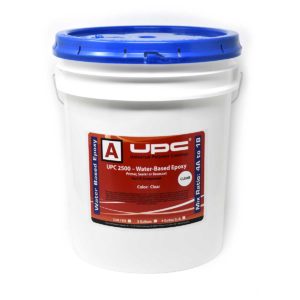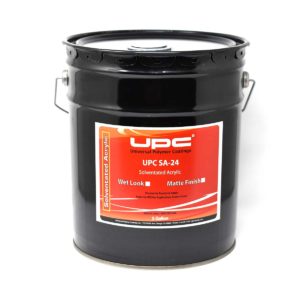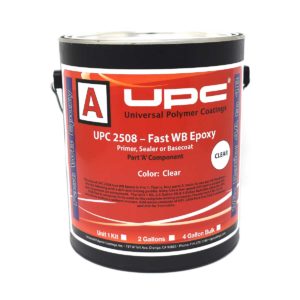UPC SA-24 Solventated Acrylic Matte
UPC SA-24 Solventated Acrylic Matte is a single-component, premium solvent-based matte finish acrylic sealer. Its chemistry provides a matte sealed surface that bonds to concrete and cementitious toppings. Its design features enhance color, rejuvenate and protect surfaces.
Download TDS:
Advantages
- VOC Compliant
- Non-Yellowing
- Interior & Exterior Use
- Color Enhancement
- Fast Drying
- Easy Installation
- Matte Finish
- Can be Rolled or Sprayed
- Non-slip if Oxide is Added
- Resists Water and Stains
Applications
The uniqueness and universality of its chemistry allow UPC SA-24 Solventated Acrylic Matte to be used in many applications, including the following:
- New or Old Concrete
- Cementitious Toppings
- Acid Stained Floors
- Stamped Surfaces
- Porous Brick
- Exterior Hardscapes
- Exposed Aggregate
- Interlocking Panels
- Natural Stone
- Masonry Surfaces
Colors
UPC SA-24 Solventated Acrylic Matte is available as a Clear base. Pigment packs can be added as well. Contact UPC Sales Rep for info.
Packaging
UPC SA-24 Solventated Acrylic Matte is available in one size:
- 5 Gallon Pail
Physical Characteristics
| PROPERTY | VALUE |
| Type | Thermal Plastic |
| Solids Contents | 24% by weight |
| 60% Gloss(2-4 mil dry film) | 88 |
| Flash Point | > 20ºF (TCC) |
| Viscosity | > 1455 cps |
| Maximum V.O.C. | > 99 grams per liter |
Product Data
| Coverage: | 200-300 SF/gal Textured surface |
| 300-400 SF/gal Smooth surface | |
| Application temperature: | Approx. 55-85°F |
| Thinning: | Not Required |
| Cure time: | 4-6 Hours for Foot Traffic |
| 48 Hours for Vehicle Traffic | |
| 5 Days for Full Properties | |
| Critical recoat time: | Approx. 1-2 hours or when tack-free |
| Shelf life: | 12 months |
Concrete Preparation
Before coating is applied, concrete must be:
- Cured – At least 28 days if new
- Dry – No damp or wet areas
- Clean – Contaminants removed
Brand new concrete must cure for at least 28 days prior to applying sealer. For new, untreated concrete, less preparation is required. Contaminants such as: curing agents, glue, waxes, paint, oil, dirt, water repellants, and anything that will prevent sealer adhesion must be removed. Prepare the concrete by sanding, grinding, sand blasting, shot blasting, or pressure washing so that the surface will be porous enough to absorb product and bond permanently. If a pressure washer is used, use a fan tip with a minimum pressure of >2,000psi. Be careful not to leave wand patterns in the finished substrate. When applying to newly installed pavers or brick, allow grout joints to dry completely before application. On surfaces expected to have vehicle traffic, it is best to remove previously applied sealers or coatings to base concrete.
Patching
The characteristics of sealed concrete allow for the user to repair cracks and imperfections only if desired. If repair is required, we recommend the use of cementitious, low-shrinking crack and spall filler. Patching must be completed at least 24 hours prior to installation of sealer.
Testing
All surfaces are not the same. It is recommended that a sample area be done before the start of the project. The test should be done on-site, using the proposed method by the assigned applicator to ensure proper adhesion and color. A sample area should also be done on any existing coatings to determine if any contaminants exist or if delaminating will occur. Test slab for alkalinity and efflorescence.
Mixing
- Shake unopened container before use.
- One-gallon to five-gallon acetone resistant pump sprayers are recommended for application of UPC SA24 Matte.
Application Instructions
After all concrete preparation has been completed and product has been thoroughly mixed, UPC SA24 Matte can be applied. UPC recommends using an acetone-rated sprayer, but a 3/4” nap, shed-resistant phenolic-core roller and paintbrush can also be used.
- Be sure to carefully mask surrounding areas to avoid accidental overspray. Optimum ambient temperature should be between 55-85°F.
- Tape off work areas to protect from foot traffic during application and drying. Mix up to 5 gallons of coating using above mixing instructions.
- Wear protective gear. Read all safety precautions. Always use in a well-ventilated area away from sources of ignition.
- Product cures quickly, so be sure to apply accordingly.
- Using an acetone-rated sprayer: Begin spraying sealer in a circular pattern while walking from left to right, then back, right to left. Work in small, manageable sections. Try working from control joint to control joint if possible. Do not allow sealer to puddle, but keep a wet edge. Note: Avoid stepping in sealer. Spiked shoes may be worn to prevent footprints. Avoid dripping sealer on concrete. Keep a drip rag on hand.
- Using a roller and brush: First, cut in around edges with brush. Then roll product on floor quickly and evenly in a “V” pattern in both directions. Roll product as thin as possible.
- Once the first coat is tack-free, a second coat can be applied evenly over the floor. Heavy traffic areas may require a third coat of sealer.
- Allow sealer to dry on the surface for at least 4-6 hours before opening area to foot traffic.
Clean-up
UPC SA24 Matte may be cleaned with solvent. Cured material may require some scrubbing. Always clean sprayer after each use, per manufacturer’s recommendations. Disposal of material must comply with all local, state and federal regulations.
Maintenance
Maintain sealed floors by sweeping. When spills occur, clean immediately and rinse dirt from the floor with water. A wet-clean is recommended for heavily-soiled areas, using a damp mop and biodegradable cleaner or rotary floor machine equipped with a white or red buffing pad and mild commercial detergent. Repeat process until water rinses clean.
Interior sealed concrete floors can be maintained by using wax or acrylic floor finishes. If any of these products are used, please refer to manufacturer’s recommended method.
Product Limitations
Ground-level concrete slabs emit invisible moisture vapor. The allowable moisture emissions for concrete are 3 lbs. / 1,000 SF over a 24-hour period based on a Calcium Chloride Test. Also, a Relative Humidity (RH) test can be performed to test for moisture vapor. RH testing results should be below 85% per ASTM F2170. If moisture is above this level, then blistering and de-lamination of coating may occur. A calcium chloride or Relative Humidity test should be performed to determine concrete moisture levels. If moisture levels exceed the 85% for RH test or 3 lbs. for Calcium Chloride, then a concrete moisture vapor control system should be used first before applying coating system. Recommended system for cases of moisture above acceptable levels is UPC 5200. UPC 5200 Moisture Lock passes F3010 spec based on E96 testing results. Please contact UPC representative for additional details.
UPC SA24 must be used on concrete that is not susceptible to hydrostatic pressure. The concrete must be placed on a well-drained subgrade. Alkali or hard-water deposits may form on the sealer at edges, cracks, joints, or other areas where water is able to enter the concrete substrate. These deposits can also form underneath the sealer in these areas. Sealer must be applied in thin coats to prevent whitening, peeling, or becoming too slippery in areas where standing water may occur. Damp objects placed on the sealer for long periods of time may leave deposits or cause stains and discoloration in the sealer.
- Always test a small area
- Add Non-slip where necessary (120-grit white Oxide)
- Do not install on damp surface or if rain is expected
- If rain has occurred within 48 hours or is expected in the next 48 hours, do not apply product
- Be sure to shut off sprinklers
- Install between 55-85°F
- Do not fan or force-dry
- Coverage rates may vary
Warranty
Universal Polymer Coatings products are warranted for one year after date of purchase. Please refer to the UPC Limited Material warranty for additional clarification.
Safety
Consult UPC SA24 Matte Safety Data Sheet. Product contains solvent and is flammable. Remember to shut off sources of ignition before beginning work. Floor can be slippery when wet, and spiked shoes are recommended during application. Use safety goggles, rubber gloves, and protective clothing when using this product. Perform work in a well-ventilated area, and use an OSHA/NIOSH approved respirator if necessary. Protective gloves and clothing are recommended.




